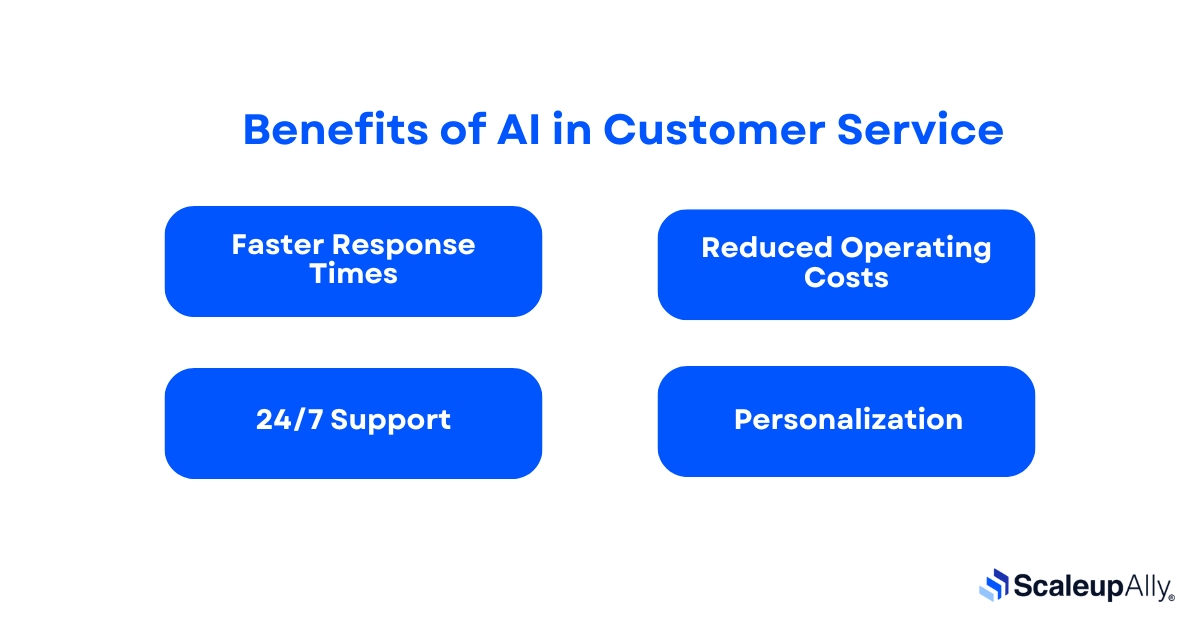
AI in Customer Service: All You Need To Know
Manu Jain | September 23, 2024 , 17 min read
Table Of Content
Finding a workplace that hasn’t embraced AI today is almost impossible. Businesses across various industries use AI for different purposes, and one of the most significant ways it’s used is to retain customers.
This blog post will explore everything you need to understand about AI in customer service and show how your company can take advantage of these changes.
Key Takeaways
- AI enhances customer experience by providing faster responses and ensuring customers never face long wait times.
- With 24/7 availability, businesses can serve customers across time zones, boosting satisfaction and brand loyalty globally.
- Automating repetitive tasks reduces operational costs and minimizes the need for extensive customer service staffing.
- Personalized AI interactions, powered by customer data, create relevant and meaningful experiences that strengthen trust.
- AI enhances agent productivity with quick summaries, intelligent search, and preserved knowledge, resulting in more efficient service delivery.
What is AI in Customer Service?
Using computer programs to support or talk to customers for basic information is termed AI in customer service. This works by customers asking questions through chatbots or voice assistants and receiving answers in seconds.
These computer programs can handle common questions about store hours or order tracking, while humans can deal with more complex issues.
Many organizations are already adopting this technology and at least 83% of decision makers expect their investment in AI to yield results over the next year.
Benefits of Implementing AI in Customer Service

1. Faster Response Times
Behind the scenes of customer service interactions are service agents navigating between screens, checking customer information and history, looking for knowledge articles, and typing out responses to customer queries.
When it’s a call, customers are often placed on hold while the agent searches for answers or handles another customer.
This wait can be frustrating and might even lead to lost sales or negative customer experiences. One of the most noticeable benefits of AI in customer service is how quickly it can respond to customer inquiries.
This AI solution has proven effective according to research by Salesforce, where 63% of professionals report that AI is helping them serve their customers better.
2. 24/7 Support
Who are you likely to be more loyal to, a service that attends to your complaints almost instantly or one that takes forever to respond? The answer is obvious.
The biggest advantage of AI customer service assistants is that they work around the clock. Traditional workers work within certain time limits, so when customers who need support outside those hours or are in different time zones are asked to wait.
What about in urgent situations?
It is agreeable that this is not the best way to run customer service.
As previously mentioned, AI chatbots do not have time restrictions–they can respond at any hour of the day or night.
For businesses, 24/7 customer service means customer satisfaction, as customers do not need to wait until the next business day to get help.
3. Reduced operating costs
Businesses can reduce operational costs by incorporating AI in customer service. Usually, a large number of customer service agents are needed, especially in peak hours to handle customer queries, but this is no longer a need since AI agents in the form of chatbots can simultaneously handle customer service needs by automating repetitive tasks without requiring help from external or additional staff.
For the fact that these AI bots do not need overtime pay or breaks and work around the clock, businesses would not need to hire workers for night shifts, weekends, or even holidays. This reduces the cost of salaries, training and infrastructure to support a large workforce over time.
There is no denying the upfront cost of using AI for customer service, but the long-term savings outweigh it and make AI a smart financial choice for many businesses.
4. Personalization
Personalization helps create a meaningful and relevant experience for customers because AI systems can analyze large amounts of customer data, including purchase history, browsing patterns, preferences, and past interactions, respond to each individual, and suggest specific actions.
For accuracy in their solutions, the AI system can browse customers’ past interactions, products they’ve shown interest in, and any issues they previously had, making the customer feel understood and valued.
For example, if someone frequently buys certain types of products, the AI can recommend similar or complementary items, thereby improving the customer’s shopping experience.
6 Examples of AI in Customer Service
1. Amazon’s Alexa
Shopping on Amazon can feel overwhelming, especially if you’re unfamiliar with managing your shopping list effectively. It’s easy to get lost in the sea of options. To make things easier for customers, Amazon developed a new chatbot feature that acts as a personal guide while you browse the site.
With this chatbot, there’s no need to deal with long waits or unnecessary steps. You can ask when your order will arrive, check where your package is, or even get suggestions for products that match what you’re looking for.
It removes the hassle of searching endless pages to find what you need.
On top of that, the chatbot can also help if the customer wants to return an item. They don’t have to go through the trouble of convincing a customer service agent to assist them—instead AI can handle it quickly and efficiently.
What Amazon Teaches Us?
Amazon, being its massive e-commerce platform, has shown how useful automation can be. By using a chatbot, they’ve cut down the time and money spent on handling customer inquiries. Simple questions that used to take up the time of multiple human agents are now answered in seconds by AI, which is faster and more efficient.
2. Tesla’s AI Bot
The top electric vehicle maker isn’t falling behind when using AI for customer service. Many people who consider buying a car usually have many questions, and many of these questions are pretty similar.
To address this, Tesla rolled out a chatbot designed to handle these common inquiries and free up time for dealing with more complicated issues.
What’s convenient is that through this chatbot, customers can even book a test drive to check whether the electric vehicle suits their needs and fits within their budget.
This means customers no longer need to travel to Tesla’s office or wait to speak with someone on hold. The AI takes care of these tasks for them.
What We Can Learn From Tesla?
Tesla has streamlined their customer service by automating it with AI. This system schedules test drive appointments for interested customers and keeps a detailed database of these interactions.
This helps Tesla track customer information and identify patterns, which ultimately helps them enhance their brand’s overall performance.
3. Expedia’s Romie
For people who love traveling, Expedia is already a popular go-to for trip planning. But let’s be honest, how often do we have everything perfectly planned out? We often still wonder where to go, what to do, or which hotel to stay at.
That’s where Expedia’s new use of AI for Customer Service comes in—it helps customers fill in the blanks in their travel plans.
With just a few taps on your phone, you can chat with the AI to make your trip planning smoother and more personal. The AI is designed to help you compare hotel prices and find the best deals nearby, making it easier to pick a place that fits your budget.
It also monitors flight prices and suggests where to go depending on the time of year. It can also help you discover things to do at your destination, like getting advice from a local. This makes it easier to put together your whole itinerary in one place.
What We Can Learn from Expedia?
Expedia encourages customers to depend on its platform to plan their trips. The whole process is interactive, quick, and convenient—things you’d expect when AI is involved in customer service.
Plus, since this feature is only available through its app, it’s likely to increase downloads and boost Expedia’s visibility, giving its brand a significant advantage.
4. AirHelp
AirHelp is a prominent travel company with many customers who often have questions. Instead of relying entirely on automated systems, they have chosen a more balanced perspective using AI in their customer service.
While many companies employ chatbots, AirHelp takes a different tactic. Their chatbots don’t handle everything; instead, they manage initial inquiries and then direct them to the appropriate human agent.
This method helps manage the flow of requests and ensures that the right person addresses questions.
Since AI isn’t equipped to deal with specific issues like baggage claims or overbooked flights, AirHelp’s chatbots serve as a first step. They filter the questions and pass only the ones requiring human input to the agents.
Lessons from AirHelp
AirHelp’s creative use of AI offers a unique example of how technology can be integrated into customer service. By carefully combining AI with human expertise, they have streamlined their processes and handled customer inquiries more efficiently.
This ensures that their agents only deal with questions within their area of expertise, keeping their workload manageable and focused.
5. Google Virtual Try-On
Google has transformed online shopping with a feature that tackles one of its biggest challenges: determining if clothes will fit and look right before buying. Imagine you’re shopping for shoes or a dress online.
You might wonder if the shoes are the right size or if the dress suits your style. This is a common concern for many shoppers. To address this, Google has introduced an impressive solution that makes this process much more manageable.
With Google’s try-on feature, customers can pick a virtual model that closely matches their body shape, size, and skin tone. After selecting the model, they can take a picture of the clothing they want. Google’s technology will then show how the clothes would look on the chosen model.
This allows shoppers to understand how the dress or shoes might look on them without leaving their homes. It’s an excellent example of how artificial intelligence can be used to improve customer experience in online shopping.
Things We Can Learn From Google
Many brands struggle with customers leaving their sites without making a purchase, often because they can’t tell if the clothing will fit or match their style.
By offering a similar try-on feature, brands could help customers make more informed decisions, potentially increasing sales and helping brands understand which items are most popular.
6. Krafton
Krafton, a well-known game development company from South Korea, is best recognized for its success with PUBG: Battlegrounds. As the company grew, it realized its existing customer service setup wasn’t quite up to the task.
With players across different regions and several brands under its wing, providing efficient customer support became more challenging.
One of the main issues Krafton faced was dealing with customer queries in multiple languages while managing unpredictable ticket volumes. These obstacles made it clear they needed a more robust and flexible system.
After careful consideration, they decided to implement a conversational AI for customer service
Among the standout features of their AI was Dynamic Content, which could adjust the website’s language and presentation based on the user’s location and other factors. This was particularly useful for Krafton, as it allowed them to serve their global audience better, ensuring that players from different countries could access support in their preferred language.
Introducing these new tools had a noticeable impact on Krafton’s overall operations. They saw clear improvements in how efficiently they could manage customer inquiries and gained better insights into the data behind their support system.
What we can learn from Krafton?
From Krafton’s experience, choosing a customer service platform that can handle multiple languages and fluctuating ticket volumes is important. It’s also clear that making use of AI tools can significantly enhance efficiency and responsiveness.
Additionally, features like Dynamic Content can improve customer satisfaction by personalizing support based on location.
How To Use AI To Improve Customer Service?
1. Increase productivity by serving as a reliable assistant
AI can boost productivity by acting like a reliable helper. For example, with tools like Einstein Copilot, customer serviceagents can quickly create personalized responses to inquiries.
These responses aren’t just generic; AI can craft replies that fit naturally with the customer’s situation, using data from various sources to make the answers as relevant as possible.
2. Generate work summaries and mobile briefings
AI can make it easier to manage work by generating summaries and briefings. Customer service AI can handle the task of summarizing case details and histories, which is especially useful for fieldwork.
This means your frontline workers can get a clear overview of the most important information without spending much time writing it themselves.
3. Preserve and disseminate knowledge throughout your organization
Another way AI can be helpful is by preserving and sharing knowledge across your organization. By connecting a generative AI tool to your service console, you can have it draft knowledge-base articles from conversation details and CRM data.
This process saves time and helps get your articles ready faster. Plus, these articles can be used in a self-service portal so customers can find answers independently.
4. Find solutions
AI can help users find answers faster. When agents or customers search for information, AI surfaces relevant results from your knowledge base directly on the search page. By investing time to create a knowledge base that is comprehensive, you ensure that accurate information is instantly available. This not only saves time but also makes it easier for everyone to access the details they need.
4 Factors to consider before implementing AI in Customer Service
1. Customer Needs and Expectations
Take the time to understand your customers, not just in general, but their needs and what they expect from your service. Some customers might love the idea of quick, automated responses, especially if they’re used to having information at their fingertips.
Others might find that AI doesn’t cut it for more complicated questions or issues. At this point, consider whether AI can give them what they want. Sometimes, no matter how good the technology is, there are cases where human interference is still needed.
So, it’s worth considering whether your customers would be satisfied with AI or feel frustrated.
2. Integration with Existing Systems
Most businesses already have some form of customer service software, like CRM systems or ticketing platforms, that they rely on.
You’ll need to ensure the AI you plan to use can work alongside these tools without issues.
If the AI doesn’t fit well, it could slow things down instead of improving them. On the other hand, a smooth integration can enhance your processes and make operations run more efficiently.
3. Quality of AI Technology
When it comes to the quality of the AI technology, you need to be cautious about this. AI isn’t all the same. Some systems are very good at understanding customer questions, even if they’re worded in a complicated or unusual way. Others aren’t as sharp, and that can lead to frustration at the customer’s end.
The more advanced the AI is in handling natural language and recognizing the context of conversations, the better it will be for your customer service.
But again, not every AI system is perfect, so you’ll need to weigh the pros and cons of the technology.
4. Training and Maintenance
Once you have the AI system, it doesn’t stop there. AI systems need regular attention, just like any other tool. You’ll have to update it, feed it new data, and tweak it occasionally to keep it accurate and useful.
There’s also the human side—your team must learn how to manage this system. Training your team to handle the AI system, knowing what to do if something goes wrong, and staying on top of maintenance is as important as building and integrating AI.
Future Trends in AI for Customer Service
1. Emotion Recognition
In the future, AI is likely to get better at understanding how people feel. It will do this by understanding how people speak, the words they use, and other subtle signs. AI can figure out how someone is feeling and respond in a way that fits their mood by paying attention to these details.
When people interact with AI, it might feel more like talking to someone who truly understands and cares about their feelings.
As a result, people could have better experiences and feel more satisfied with the service they receive.
2. Real-Time Language Translation
AI is set to play a bigger role in providing translation services as they happen. This means that people speaking different languages can understand each other more easily. This is a big deal for businesses because it will help them reach and assist customers from all over the world.
Companies will find it simpler to offer help in various languages, making it easier for people who don’t speak the main language to access their services.
In short, AI will make it much easier for businesses to communicate with a diverse range of customers and offer better support to everyone, no matter what language they speak.
3. AI-Powered Virtual Assistants
AI virtual assistants are expected to get much smarter in the coming years. They’ll be able to complete tasks faster and offer much more detailed help. These future assistants will be capable of handling complicated tasks, such as managing transactions or solving complex problems, with only a little help from humans.
As they evolve, they will better manage various activities and provide more in-depth support.
Conclusion
Offering faster responses and personalised interactions, AI and customer service are a perfect match. Embracing AI in customer service leads to happier customers and better operations, benefiting both companies and clients.
To summarise the context, Edsger Dijkstra aptly said, “The question of whether a computer can think is no more interesting than the question of whether a submarine can swim.”
For customised Generative AI solutions, including custom chatbots, ScaleupAlly is the ideal partner to explore your options and elevate your service. Talk to us today, and let’s get started.
Frequently Asked Questions
Q: How is AI used in customer service?
AI in customer service helps with answering common questions and making personalized recommendations to the customers. It speeds up response times, reduces workload, and improves efficiency in handling basic customer inquiries.
Q: Is AI going to replace customer service?
AI won’t fully replace customer service. While it handles routine tasks efficiently, human agents are still needed for complex problems that require empathy, critical thinking, and personalized solutions.
References:
Related Blogs

OpenAI for Businesses [Benefits, Use Cases & Challenges]
Discover the benefits of OpenAI for businesses. From reducing costs to scaling operations and enriching customer experiences. Real-world use cases included.
ScaleupAlly Team
Dec 16 ,
11 min read

Best 11 Agentic AI Tools in UAE: Accelerating Digital Transformation
Discover the top 11 agentic AI tools in UAE for 2025. Explore features, benefits, and tips to choose the right AI tool for your business growth.
Manu Jain
Nov 6 ,
9 min read

How to Choose an AI Development Company in Dubai: A Complete Guide
Find out how to choose the right AI development company in Dubai. Learn key factors, local considerations, and tips to select the best partner.
Manu Jain
Nov 6 ,
9 min read


